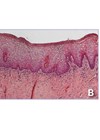Skinspan refers to the years of life during which skin remains healthy, youthful and attractive and is influenced by genetic, metabolic and lifestyle factors. While ultraviolet (UV) exposure is a potent environmental driver of skin ageing, our hormones play a vital role in determining skin health and appearance.
Ageing of the skin is three-dimensional
Ageing occurs across all layers and is accelerated by resorption of the facial bones; ageing of the skin involves degradation of the extracellular matrix, deterioration of skin micro-architecture, deflation of subcutaneous fat, and descent of soft tissue [1]. In the epidermis, ageing is associated with a decrease in epidermal thickness, melanocyte and Langerhans cell density and flattening of the dermal papilla. In the dermis, there is an age-related decline in fibroblast number and activity representing diminished regenerative capacity and deterioration of the collagen-elastin matrix.
Hormones and skinspan
Hormonal senescence affects nearly all the hallmarks of ageing and contributes to skin deterioration and degradation. Phenotypic stigmata of hormonal imbalance include pretibial myxedema, dry hair and brittle nails (thyroid), thin skin and easy bruising (adrenal), acrochordons (skin tags) and acanthosis nigricans (insulin resistance), hormonal acne (androgens), poikiloderma of Civatte (oestrogen) [5]. Patients seeking aesthetic enhancement may present demonstrating these common signs. Hence it behooves the expert provider to consider hormonal health as a cornerstone to skin health, appearance and aging. Indeed, the skin can be considered a visual foray into our patient’s health and bioage.
Emerging insights into hormonal effects
In this classical model of endocrine signalling, hormones in circulation reach their tissue target and bind receptors either on the cell membrane or within the nucleus to control gene expression and modulate hormone receptor biosynthesis [2]. Emerging insights reveal that the endocrine system is far more complex than ever imagined. The classical endocrine system operates in tandem with short range hormonal cell to cell and intracellular signals via paracrine, autocrine, and intracrine pathways.
The skin as an endocrine organ
The skin is both a hormonal target and an endocrine tissue involved in the activation and production of hormones. The skin is integral in the activation of hormonal precursors to both androgens and vitamin D and skin-derived hormones work both locally and exert systemic effects remotely.

Oestrogen and skin ageing
Of all the hormones affecting skinspan, oestrogens are perhaps the most influential. Oestrogens have widespread affects modulating epidermal keratinocytes, dermal fibroblasts, melanocytes and skin appendages including hair follicles and sebaceous glands.
Estradiol is the predominate form of oestrogen throughout a woman’s reproductive lifespan and is integral to supporting healthy skin. Estradiol promotes collagen and elastin production, accelerates wound healing, reduces skin inflammation and protects against skin photoageing and photocarcinogenesis [3]. Throughout the menstrual cycle, skin thickness varies in relation to changes in estradiol levels and is thickest mid cycle with ovulation.
Menopause and the skin
At menopause, with the precipitous decline in oestrogen, women experience fast ageing of the skin. Rapidly, menopausal women experience increased skin wrinkling, laxity and dryness along with an increase in redness, sensitivity, and dyschromia [3].
The menopausal loss of oestrogen is particularly associated with ageing of the peri-oral region. The lips, much like the vaginal labia, can be considered a biomarker of tissue oestrogen levels. Oestrogen loss leads to perioral rhytids, ageing of the lips with volume loss, dryness and pallor, elongation of the nasal tip to lip distance, and downward descent of the lateral commissure extending into a deep furrow in the marionette region, eventually forming the jowl [2]. Together these changes can be considered the ‘sag sign’ of menopause.
The collagen content of skin decreases by 30% in the first five years after menopause occurring in parallel to a decrease in bone density. Oestrogen therapy after menopause has been shown to increase skin hydration and thickness, collagen content and reduce photoageing [4]. Women who take oestrogen after menopause with or without progesterone demonstrate significantly fewer wrinkles.
A new generation of hormone modulating cosmeceuticals aims to leverage estrogen’s beneficial effects on the skin. The future use of exogenous oestrogen therapy, oestrogen metabolites, oestrogen receptor modulators (SERMS) and activators of non-genotrophic oestrogen-like signaling molecules (ANGELS) holds promise to mitigate menopause-associated accelerated skin ageing.
Androgens and the skin
The primary androgen, testosterone, is produced in the Leydig cells of the testis in men and in women is produced in the adrenal gland (25%), the ovarian granulosa cells (25%) and in the periphery where 50% of systemic testosterone is converted in fat tissue from androstenedione. In women, most testosterone is bound to protein with only 1% of total testosterone freely circulating unbound and available to exert downstream tissue effects. Androgens and androgen receptors (AR) affect the skin and stimulate skin appendages including hair follicles and pilosebaceous glands. Conditions associated with increased androgen levels produce skin stigmata including: hormonal acne with nodulocystic eruptions typically on the lower face, chest and back, hormonal hair loss, and in women, hirsutism or increased hair growth in sexually determined areas including the chin, areola and inner thigh. In women with polycystic ovarian syndrome the increased levels of luteinising hormone drive higher ovarian testosterone production and peripheral conversion.
While targeted end organ treatments are helpful to women manifesting signs of hyperandrogenism including acne care and depilation, there are several approved hormone regulating treatments. Minoxidil is a topical treatment for androgenetic alopecia (AGA) and female pattern hair loss. Minoxidil is a peripheral vasodilator that stimulates growth of keratinocytes and prolongs the anagen phase. Finasteride and dutasteride are 5-alpha-reductase inhibitors that reduce conversion of testosterone to the more potent di-hydrotestosterone and are approved to treat male AGA but frequently used topically off-label in women.
Insulin disorders and the skin
Insulin resistance, hyperinsulinemia and metabolic disorders can manifest on the skin and affect skin ageing. Insulin resistance can increase the activity of ARs and potentiate androgenising effects on the skin including hormonal acne.
Insulin-like growth factor 3 (IGF-3) is prevalent in the skin and associated with hormonal pigment disorders including seborrheic keratosis (sunspots), ephelides (freckles), and melasma.
Skin ageing by AGEs
Advanced glycation end products (AGEs) are produced both endogenously and arise from the diet. Insulin resistance predisposes to endogenous AGEs which can irreversibly bind to collagen and elastin fibres causing glycation of the protein and degradation of the tissue. The long half-life of collagen (15 years) and elastin (70 years) allow AGEs to accumulate in the skin accelerating ageing through increased oxidative damage and inflammation. Genetic susceptibility to collagen glycation and accelerated skin ageing arises through two mutations in the glyoxalase gene (Glo‑1). This genetic trait is potentiated through toxic sugars in the diet and UV exposure [2]. Dietary AGEs (dAGEs) contribute significantly to glycation and arise from consuming animal proteins that have been cooked at high temperatures under dry heat.
The sunshine vitamin and the skin
Vitamin D3, cholecalciferol, is a fat-soluble prohormone steroid with endocrine, paracrine and autocrine functions – the latter two mechanisms alter genetic transcription via the vitamin D receptor which is found on nearly every cell in our body. Vitamin D3 can be biosynthesised in the skin in a process dependent on UV exposure and is subsequently converted by the kidney into its final active form, calcitriol. Both endogenous vitamin D production and consumption through dietary sources are often inadequate resulting in frequent vitamin D deficiency syndromes.
Vitamin D deficiency is linked to increased skin permeability, increased risk of infestations and infections, auto-immunity (psoriasis, pemphigus vulgaris, bullous pemphigoid), inflammation and skin cancer and may contribute to hair loss and vitiligo.
Hormones and skinspan
Ageing is not inevitable. The health, appearance and ageing of our skin can be proactively managed with a targeted and multi-modal approach. In addition to the arsenal of aesthetic medical interventions, hormonal modulation can play an important role in enhancing skin health, appearance and ageing.
The future of medicine is getting personal. A bespoke beauty plan to target the genomic, epigenomic, hormonal, and metabolic factors affecting health and appearance is the new standard for advanced aesthetic care. Hormonal optimisation is a key pillar of the new era of functional aesthetics.
References
1. Hall G, Phillips TJ. Estrogen and skin: The effects of estrogen, menopause, and hormone replacement therapy on the skin. J Am Acad Dermatol 2005;53(4):555–68.
2. Kamp E, Ashraf M, Musbahi E, DeGiovanni C. Menopause, skin and common dermatoses. Part 2: skin disorders. Clin ExpDermatol 2022;47(12):2117–22.
3. Lephart ED, Naftolin F. Menopause and the skin: old favorites and new innovations in cosmeceuticals for Estrogen-Deficient skin. Dermatol Ther 2020;11(1):53–69.
4. Reus TL, Brohem CA, Schuck DC, Lorencini M. Revisiting the effects of menopause on the skin: Functional changes, clinical studies, in vitro models and therapeutic alternatives. Mech Ageing Dev 2020;185:111193.
5. Wines N, Willsteed E. Menopause and the skin. Australas J Dermatol 2001;42(3):149–60.
Declaration of competing interests: None declared.
COMMENTS ARE WELCOME








